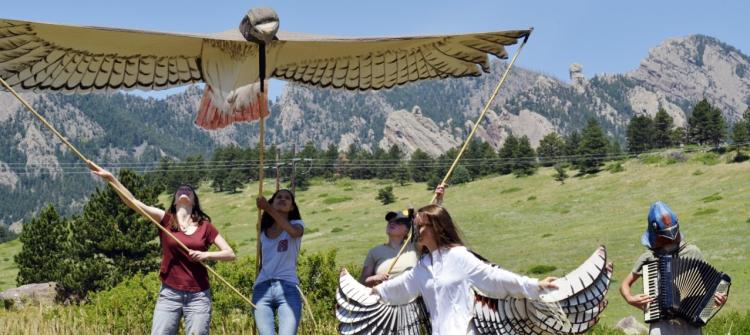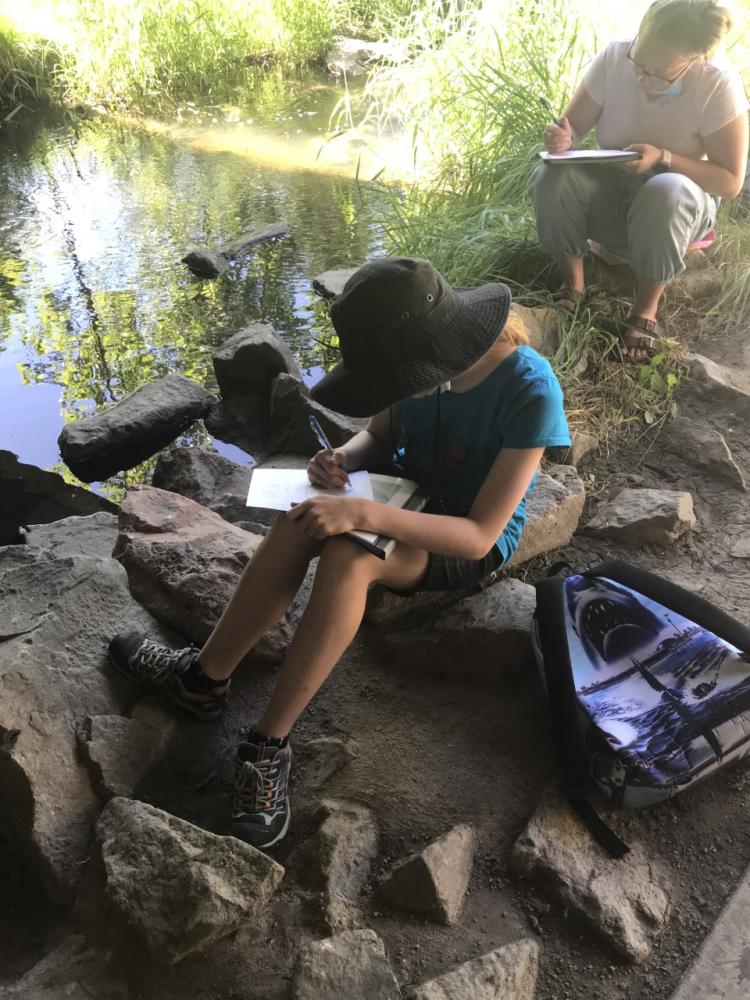Teen birdwatchers turn research into performance art
The Side by Side project teaches high school students about local birds’ ecosystems through performative arts and scientific observation
Barn swallows nesting under a bridge near CU Boulder’s East Campus swoop and dive for insects to feed their chicks, unconcerned by a group of high school students noting the birds’ movements in their arts and sciences field journals.
Through a grant provided by the National Science Foundation (NSF), this group of 11 high school students in STEM (science, technology, engineering and math) spent their summer days observing the birds interacting with the environment through the guided arts and sciences approach of the Side by Side project.
An outreach project, Side by Side was created by Beth Osnes, professor in theatre, and Rebecca Safran, professor in ecology and evolutionary biology, for underserved female-identifying or nonbinary students. Osnes and Safran hope that educating and empowering these students in STEM fields and in the arts will diversify approaches, perspectives and solutions to environmental challenges.
“We want young people to notice there are fascinating ecosystems even in the most ordinary spaces,” Osnes said. “At first glance, that underpass where the swallows’ nest seems unremarkable when you look at it from above. But when you get underneath and start spending time and engaging in scientific and artistic observation, a thriving ecosystem is revealed to us.”

At the top of the page: Ting Lester as Hummingbird. Photo by Bex Anderson. Above: Filming at South Mesa Trail. Photo by Bex Anderson
Sofie Wendell, one of the high school participants, describes the impact of this project on herself and our future: “Here, protected by tall pine trees, surrounded by strong mountains, and among such beautiful individuals, I feel as though I belong,” Wendell wrote.
“Here my ideas hold weight, they matter. Here I am not judged or overlooked. Here I am given the opportunity to connect not only with nature, but with new friends and unique ideas. Together we are building the bridge to an equitable, survivable and thrivable future through science, art and love. I know I belong because this feels like home.”
Here, protected by tall pine trees, surrounded by strong mountains, and among such beautiful individuals, I feel as though I belong.
Safran and Osnes developed Side by Side to enhance the strength of arts and sciences crosstalk and to merge storytelling with scientific data through the creation and performance of large-scale puppets of many local birds.
“Their enthusiasm, hard work and pure engagement speak volumes about how each individual student experienced this summer's iteration of Side by Side,” Safran said. “We saw a lot of personal pride associated with the work they did both individually and as part of the group. To witness each participant really stretching themselves to take flight was amazing.”
After weeks spent observing the barn swallows, each student was encouraged to choose a different type of bird within that same environment, such as great blue herons, red-winged blackbirds, or crows, to observe, research and embody through puppetry.
“I wanted them to feel like they had something in common with the birds,” Safran said, “so I asked them questions about their favorite colors, habitats and diet. It was a fun way to interact with each student and to help them find a bird species they could feel connected to.”
The youth partnered with scientists, artists and CU Boulder graduate students who guided them through observations of the natural world, especially the variety of birds in different habitats.
By combining science and art in their observations, Side by Side was intended to build confidence in young STEM scholars and provide opportunities for falling in love with, and thus wanting to save, the natural world.

The goal for the participants was an increased feeling of belonging in nature; as part of a local community engaged in action for climate solutions; and in the STEM and artistic community focusing on climate solutions.
Journal notes and sketches from their time spent in the field have been developed into a script for a public performance to be held Aug. 16 on Boulder’s Open Space Mountain Parks (OSMP).
This summer’s project continues one started in 2018 in partnership with Molly McDermott, now a PhD candidate in ecology and evolutionary biology, and Aaron Treher (MFAArt’18). Chelsea Hackett also partners with this project through SPEAK, an organization to support and celebrate the voices of young women and girls.
Side by Side is sponsored by the NSF, Inside the Greenhouse and NEST Studio for the Arts, and has previously partnered with the sculpture and post-studio practice area of the Department of Art and Art History, and the Art and Rural Environments Field School.
Osnes and Safran are also cofounders of Inside the Greenhouse, an initiative within the newly formed Center for Creative Climate Communication and Behavioral Change that focuses on developing creative, effective climate communication. They are trying to put into practice the best of the social sciences, grounding it in the physical and life sciences and then expressing it through the arts.
“It’s about inspiring young people to choose careers that matter and can make a difference and helping them realize they can do it from different perspectives,” Osnes said. “If you care about climate change, you don’t have to just be a scientist, you can also make a difference through performance and theatre.”
Two filmmakers have made films of this summer’s art hikes on open space that include the art and poems created by the youth. The art hikes were filmed at three OSMP hiking locations: South Mesa near Eldorado Springs, Sawhill Ponds east of Boulder and Artist Point on Flagstaff Mountain. The videos will be posted on the Boulder OSMP website and linked to QR codes posted at the trailheads.
“We need a new story to get us through this climate crisis and so we need new storytellers. This focus on barn swallows is serving as a portal to our larger relationship to the natural worlds as we claim our responsibility to heal the planetary ecological crisis (that) we all face,” Osnes said, adding:
“Artistic and science-based voices are underrepresented in authoring our cultural story of how we will approach this greatest challenge humanity has ever faced.”
For information on the performance, go to the City of Boulder’s Nature Hikes and Programs website.

